Menus
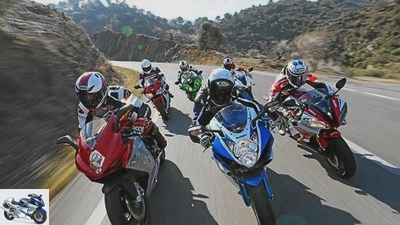
Jahn
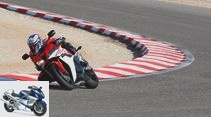
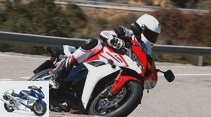
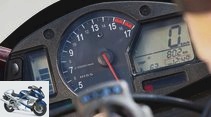
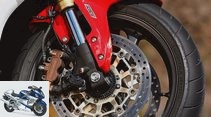
33 photos

Jahn
1/33
2012 super sports cars in comparison: Honda CBR 600 RR, Kawasaki Ninja ZX-6R, MV Agusta F3 675, Suzuki GSX-R 600, Triumph Daytona 675 R and Yamaha YZF-R6.
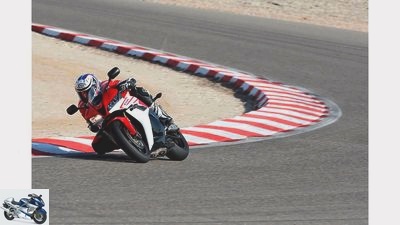
Jahn
2/33
Clearly the most everyday motorcycle on the test field, and not just because of the ABS: The Honda CBR 600 RR is quite comfortable, almost comfortably, for a super sports bike. For the racetrack, however, the damping reserves are only just enough.
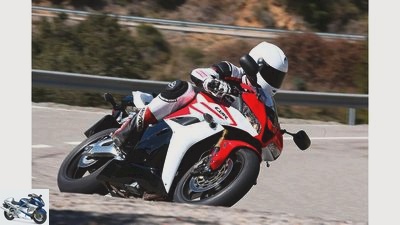
Jahn
3/33
Your engine is the weakest in comparison, which costs points in the everyday standings and seconds on the racetrack.
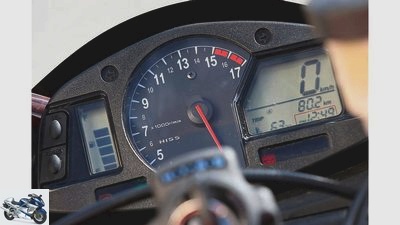
Jahn
4/33
Honda CBR 600 RR: The tachometer reads pleasantly, but a cockpit update is announced.
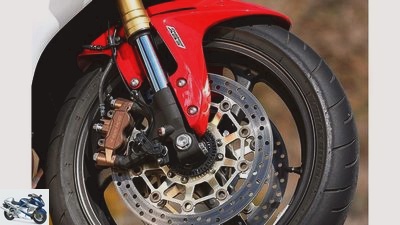
Jahn
5/33
Honda CBR 600 RR: One-piece brake calipers with steel pistons ensure fade-free deceleration.
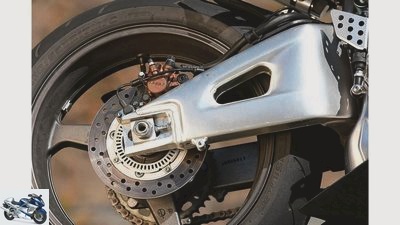
Jahn
6/33
Honda CBR 600 RR: A work of art from a swing arm, copied from MotoGP machines.
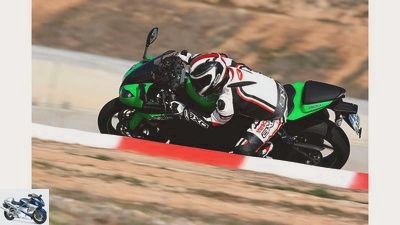
Jahn
7/33
The Kawasaki Ninja ZX-6R needs racing tires in order to develop its full chassis potential.
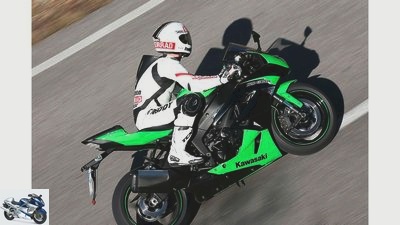
Jahn
8/33
But then she manages the second fastest lap time behind the Triumph Daytona.
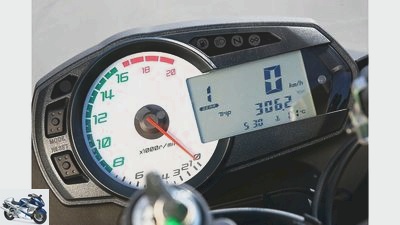
Jahn
9/33
Kawasaki Ninja ZX-6R: The green area in the cockpit shows what is required. Speeds.
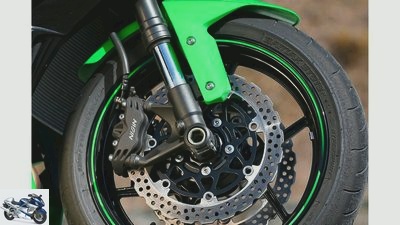
Jahn
10/33
Kawasaki Ninja ZX-6R: Powerful pliers, thick discs, biting surfaces – the Kawa brakes progressively.
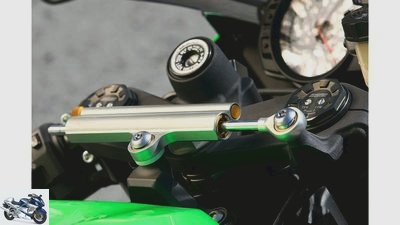
Jahn
11/33
Kawasaki Ninja ZX-6R: Keeps the steering calm – Ohlins steering damper with a wide adjustment range.
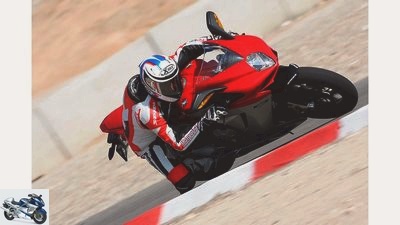
Jahn
12/33
Nice, in terms of price, compact and handy: This is how the new MV Agusta F3 675 presents itself.
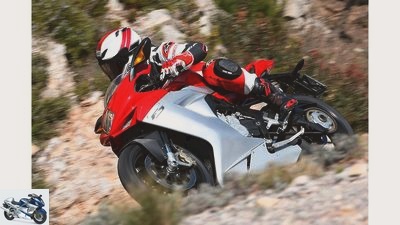
Jahn
13/33
The tuning of the engine takes getting used to, it requires a lot of concentration in all types of driving.
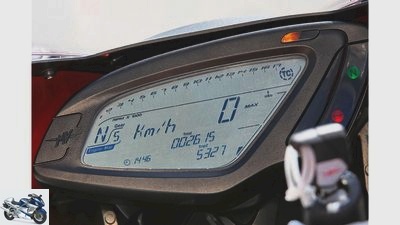
Jahn
14/33
MV Agusta F3 675: The multifunctional display instrument is actually a subject.
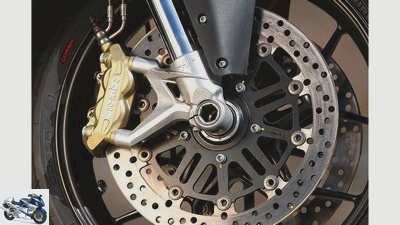
Jahn
15/33
The MV relies on split Brembo calipers and brakes very well with them.
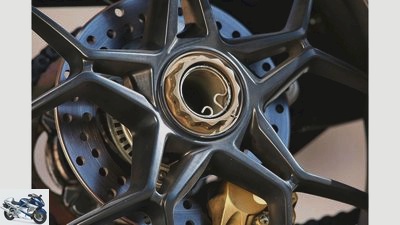
Jahn
16/33
MV Agusta F3 675: MV equips even mid-range athletes with a complex single-sided swing arm.
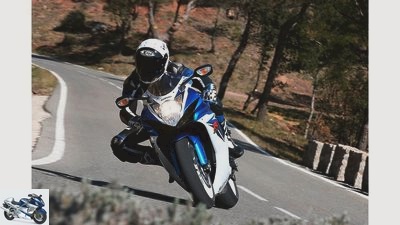
Jahn
17/33
Such an inconspicuous and in many ways so good motorcycle. The Suzuki GSX-R 600 wins the everyday standings anyway, even against the Honda, which has an ABS advantage.
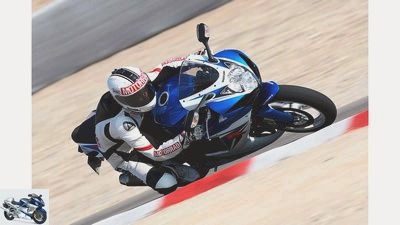
Jahn
18/33
What it lacks for the racetrack are just sharper brake pads and slightly revised spring elements.
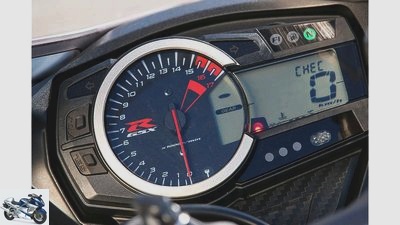
Jahn
19/33
Triumph Daytona 675 R: There is plenty of reading material in the cockpit, clearly arranged.
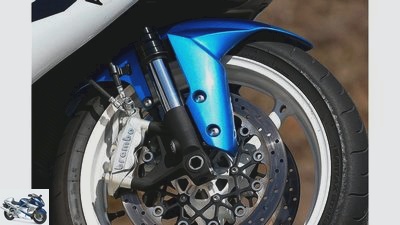
Jahn
20/33
Suzuki GSX-R 600: With other pads, the Brembo one-piece ran out to great shape.
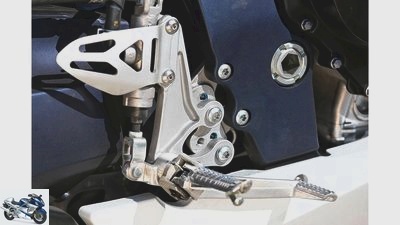
Jahn
21/33
The footrests of the Suzuki GSX-R 600 are variable – here already in the more comfortable position.
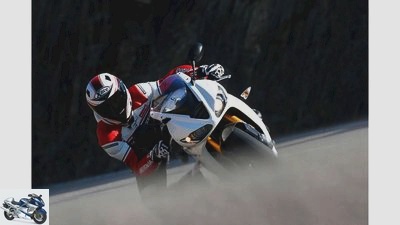
Jahn
22/33
The Daytona 675 R goes into the corner like no other and delivers crystal-clear feedback from the front wheel.
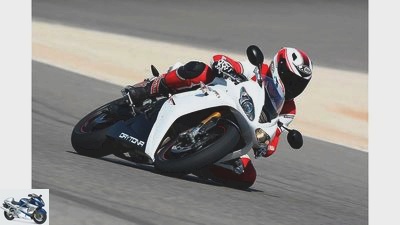
Jahn
23/33
However, the extreme sitting position is exhausting in everyday life.
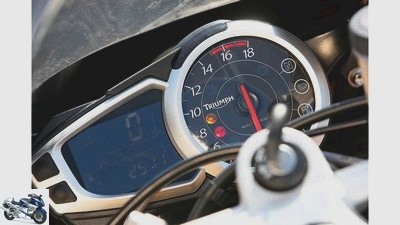
Jahn
24/33
Triumph Daytona 675 R: Red from 15,000 rpm – the three-cylinder actually only turns up to 14,000. Enough too.
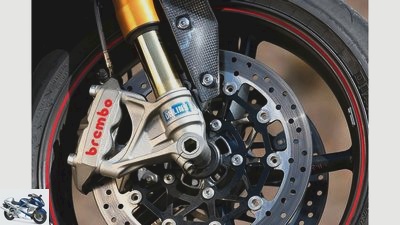
Jahn
25/33
Triumph Daytona 675 R: The finest brakes, but the discs rubbed slightly in the end.
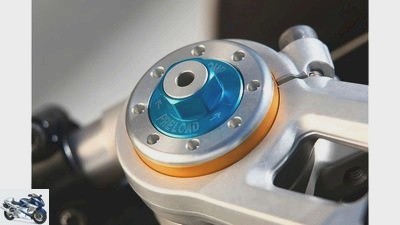
Jahn
26/33
Triumph Daytona 675 R: Small details tell the connoisseur what famous spring mechanism is built in.
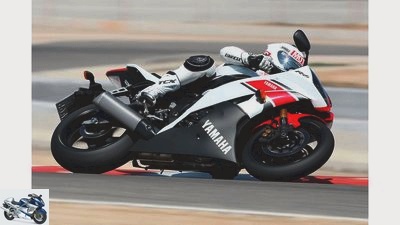
Jahn
27/33
With the Yamaha YZF-R6, too, the racetrack photo has to be enlarged; only then does she find herself and achieve the second best rating despite blunt brakes.
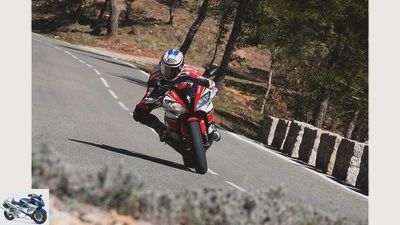
Jahn
28/33
On the country road, the standard tires are particularly displeasing.
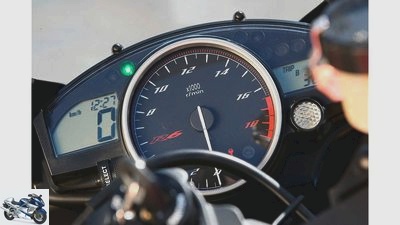
Jahn
29/33
Yamaha YZF R6: The sensation in this conventional round clock is the red area.
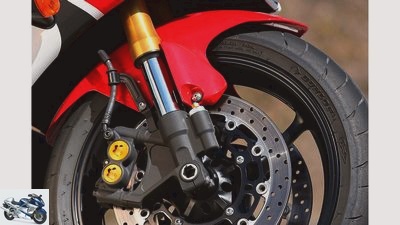
Jahn
30/33
Yamaha YZF-R6: brake calipers with plugs, axle mount with sprue for the compression valve.
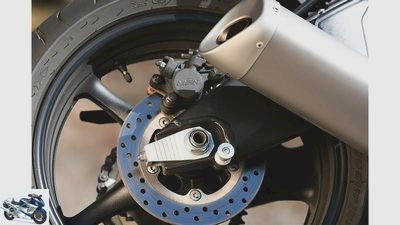
Jahn
31/33
For its high price, the Yamaha YZF-R6 has been carefully crafted, at least down to the last detail.
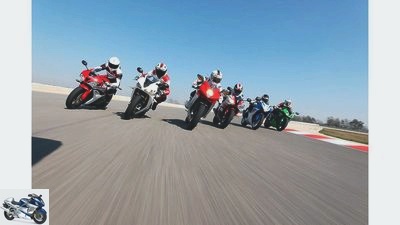
Jahn
32/33
For the MOTORRAD tests, all six motorcycles were fitted with Metzeler Racetech K2 tires.
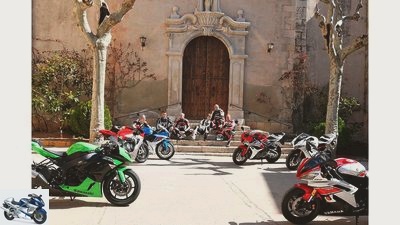
Jahn
33/33
Even the smallest village in the Spanish hinterland is steeped in motorcycle enthusiasm. The curious crowd crowded behind the photographer.
Test: 600cc sports motorcycles – with suspension settings
Comparison test of the 600 super sports car in 2012
The six motorcycles in the Supersport class had to assert themselves equally on country roads and racetracks. The new MV Agusta F3 was able to show the area in which it wanted to set the tone.
The curve paradise is located northwest of Cambrils, a holiday resort on the Spanish Mediterranean coast. Dozens of beautiful roads wind through the hilly landscape behind the coastal plain. Wide, with wide curves some, narrow, the others flanking a ravine in tight bends, all with immaculate, grippy asphalt. Ideal terrain for country road tests with sporty motorcycles. And anyone who has crossed the staggered chain of hills, sometimes in a heavy curve frenzy, northwards into the interior of the country will find a small, fine race track near the town of Alcarràs and thus an equally ideal second location for this comparison test. The shooting range, so to speak, to stay in the jargon of biathlon. This comparison of the 600 four-cylinder and the 675 three-cylinder, the first comprehensive since the spring of 2009 in MOTORRAD, has caused the M.V Agusta F3 675. It is the first completely redesigned challenger for the super sporty middle class since the Triumph Daytona 675, and it came onto the German market in 2006.
Buy complete article
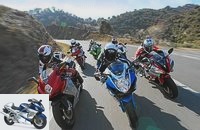
Test: 600cc sports motorcycles – with suspension settings
Comparison test of the 600 super sports car in 2012
Jahn
The Honda is quite comfortable for a super sports car, almost comfortably tuned. For the racetrack, on the other hand, the damping reserves are only just enough.
Since the 2011 season, the Triumph has also been available in the exclusive R version, which costs 12,990 euros instead of 11,490 euros, with Ohlins suspension elements, Brembo monoblocs, shift assistant and some carbon parts, which deny this comparison. For exactly 1000 euros less, the MV Agusta offers less noble parts, but a wide range of equipment, which in addition to various motor mappings that can even be freely programmed in certain parameters, also includes traction control as standard. In terms of price, the MV is right in the middle of the group of Japanese 600s, whose recently revised representative is the Suzuki GSX-R 600. At the start of the season last year, it mainly slimmed down weight, received many detail improvements on the engine and a new fairing. As far as the entry into the electronic age is concerned, it leaves it at a small step by offering two engine mappings, which mainly affect the throttle response.
Jahn
The Kawasaki needs racing tires in order to develop its full chassis potential.
The remaining representatives of Japanese motorcycle power are tried and tested warhorses. In 2010, the Yamaha YZF-R6, which was presented as the RJ6 model in 2006, received a longer tailpipe and a mild engine update, which of course was not noticeable in large-scale production. The Honda CBR 600 RR properly upgraded in 2009 with an electronically controlled composite brake and ABS. At the same time, Kawasaki launched the ZX-6R, which is still up-to-date today, with a heavily revised engine and new chassis, significantly lightened and redesigned. The European-Japanese race in the supersport class, which is occupied in this way, is primarily a discussion of engine types.
While the Japanese manufacturers agree on the most important dimensions of their 600 four-cylinder, bore and stroke are all 67 by 42.5 millimeters, MV and Triumph have quite different views on how a 675 in-line three-cylinder should be designed. The MV developers chose a full five millimeters more bore than Triumph for their engine, which should rotate higher with a correspondingly shorter stroke and larger valves and thus generate more power. As the performance curves show, this was successful, if only just barely. The curves also suggest that the price has to be paid for the torque curve – the MV can only outperform the smaller four-cylinder engines beyond 10,000 rpm, and the Triumph with the same displacement only above 13,000 rpm.
Jahn
MV Agusta F3 675: The tuning of the engine takes getting used to, it requires a lot of concentration in all types of driving.
When driving, the response behavior of the MV engine proves to be rough and difficult to calculate; In contrast to the mechanically unplaned, throaty engine sound, this peculiarity lacks any charm. The driver of the F3 must always be highly concentrated. If, for example, he unintentionally moves the smooth throttle grip when driving over bumps, the not yet perfectly programmed ride-by-wire throttle valve control immediately converts this into a robust load change or sudden propulsion. This also irritates on the racetrack – and there even professionals like our co-tester, the Swedish Superbike champion Freddy Papunen. Especially when driving on the country road, the peculiarity of the MV engine to leave the overrun cut-off range below 4000 rpm and inject gasoline again is strange, which often leads to being pushed into a curve with slight force, although one prefers to go with it closed gas would still delay.
The Kawasaki ZX-6R does the exact opposite. She feels as if her throttle valves are stuck to the stop with a drop of honey – especially after long periods of rolling, as is inevitable when driving downhill before a bend, the Kawa engine is reluctant to accelerate again. Less pronounced, but nevertheless sometimes annoying, this is also noticeable on the racetrack. The rest of the field is in the very good to tolerable range, with the bandwidth ranging from “direct, but beautifully supple” (Triumph) to “a little too much play in the drive train” (Honda). In particular, a very narrow road, the longest straight of which is less than 300 meters for a good 15 kilometers, reveals differences in this criterion – of course, when a load change is due every few meters. Actually, light, one- and two-cylinder supermotos would be the right devices here. Well, the MOTORRAD test team could still live well with the luxury problem of driving stump-steered super sports bikes.
Especially when she had relearned how to handle the consistently necessary high speeds. Because they are a condition and require a change in listening habits. What already sounds like the full acoustic alarm in the ears of the riders of fat naked bikes, marks the area in the 600s where they are just beginning to feel good. And on the racetrack, the high-frequency screeching and milling sounds simply phenomenal. One thinks: Simple series engines work reliably with crazy speeds of 15,000 rpm or even more. Even those who perceive the sound of the super sports car as noise can confidently acknowledge the technical performance behind it.
Jahn
The Suzuki GSX-R 600 wins the everyday rating. For the racetrack, it lacks sharper brake pads and slightly revised spring elements.
Once you have got used to the required speed level, the screeching devices, which previously appeared to be weak-chested, reveal considerable differences in pulling power and acceleration from medium speeds. Then the hour strikes for the inconspicuously pleasing Suzuki. If you turn to the performance diagram, you will see a light blue curve protruding from the bundle of lines of the MV and the three other Japanese women. It belongs to the GSX-R 600 and marks in theory what can be felt in practice at the exit of each curve. Less noticeable in the diagram, the Kawasaki is also able to convince when driving, and that also applies to the racetrack with the latter two. The Honda pleases with a steady power delivery, but needs, when the others fire, always higher speeds to keep up. And when the competitors are already running at higher speeds themselves, she falls behind. Over the entire test program, the impression is solidified that the CBR could use an engine overhaul. Rumors are currently increasing that a successor will be presented in the middle of the year.
Jahn
The Daytona goes into the corner like no other and delivers crystal-clear feedback from the front wheel.
The Yamaha literally sags up to around 10,000 rpm, and even above where the movements of the variable intake stacks are reflected in the waves of the power curve, it remains largely below the performances of the competition. On the already mentioned narrow road with its many bends, it tempts you to simply leave first gear engaged and use the enormous speed reserves. But it will be a pretty hectic drive. The high-revving Yamaha engine and thus automatically its driver only feel really at home on the racetrack, where the high revs usually go hand in hand with high speeds and there is no such jerky stop-and-go as in everyday traffic. And then there is the triumph. Your engine is simply the best in the whole field – from almost every angle. Even in terms of smoothness, it can lead the four-cylinder engines, which are tingy in some speed ranges, a bit ahead of them, especially its rough three-cylinder competitor, the MV. In any case, it is unsurpassed in terms of sound development. Only the slightly higher consumption compared to the Japanese motorcycles is to be chalked up to him.
Jahn
The Yamaha YZF-R6 achieved the second best rating on the racetrack, despite blunt brakes.
Thanks to its handiness, the MV Agusta was able to round down the favor of the testers. The ease with which she danced across the narrow strip of asphalt freed up capacities that are necessary to deal with the unruly engine and the stiff, not always precisely operable gearshift. Since the F3 does not attract attention among its competitors, neither because of its particularly handling-enhancing chassis geometry, nor because of its particularly low weight, it is reasonable to assume that the backward rotating crankshaft actually produces a noticeable effect to increase maneuverability. But the series tires certainly have their share in the ease of turning. Both Europeans roll on standard Pirellis, the MV on Diablo Rosso Corsa, the Triumph even on disguised Supercorsa SP racing tires, and they are both known for their leadership qualities, i.e. handiness and steering precision.
Three of the four Japanese machines, on the other hand, are fitted with their respective special specifications, which have one thing in common: the front tires have to be light and ensure a high level of comfort as well as unshakable straight-line stability, at the expense of steering precision and maneuverability. That is why they are comparatively soft in structure. When braking in front of the curve, the dynamic wheel load distribution makes the contact area relatively wide and the motorcycle turns more slowly.
This effect can be felt most clearly on the Kawasaki, which literally pulls into the broad line even with gentle braking in an inclined position. Then the Suzuki and the Honda follow. The Yamaha with its Dunlop Qualifier in the standard version also looks doughy when turning in and changing lean angles, and of all of them it is the one that catches the strongest steering impulses on uneven ground. The great importance of the tires for these peculiarities was once again proven when driving on the racetrack. There all the motorcycles rolled on Metzeler Racetech K2, real supersport racing tires, and especially the Kawasaki and the Yamaha suddenly drove each other as if they were greedy for curves. Which is not to say that MOTORRAD recommends these tires as everyday tires; that would be problematic if only because of their narrow temperature window. It’s just a matter of showing a tendency: Front tires with a suitable contour and more stable structure make a motorcycle light-footed and help with precise driving.
Ergonomics, the design of the driver’s position, is another important component of the chassis quality of a motorcycle, and here too there is anything but boring miscellaneous. The Honda offers its handlebars at a comfortable height, which is most favorable for driving in everyday traffic. However, the footrests are a bit too high for this, resulting in a very narrow knee angle that is annoying for some drivers. As it turned out on the race track, the notch position is due to the lean angle required for fast driving. The footrests are even higher on the Suzuki. There, however, they can be moved down a good centimeter, and then the GSX-R is very comfortable. The position on the Kawasaki and MV Agusta is inconspicuous in the best sense of the word. Hands and feet find their position on them as a matter of course, and the driver can move around easily on both motorcycles.
All the sporty gymnastics exercises, sliding backwards when braking sharply, the hanging-off for cornering anticipated while driving straight ahead, cost much more power on the two sporty extremists, the Triumph and the Yamaha, than on the other motorcycles. With the Daytona, this is mainly due to the low handlebars. When driving like a race, the meaning and advantage of their position is immediately apparent: Daytona drivers enjoy an unsurpassed authentic feeling for the instantaneous reactions of the front tire. In everyday life you only get an authentic feeling for the weaknesses of your own arm and back muscles. The Yamaha, too, has its handlebars low, and the seat and tank flanks are designed in such a way that the driver slides forward too easily when braking, where he then feels too far forward. It is not without reason that many Yamaha racers cover the tank with bubble wrap, which gives the knees better support when braking.
With a price range of just under 11,900 to just under 13,000 euros, the mid-range Supersport is quite an expensive pleasure today, especially if you look at the 1990s for comparison. At least a good part of the price increases that have taken place since then have gone into the quality of the equipment, not least the spring elements. An amateur racing driver nowadays does not have to reflexively swap shock absorbers and fork inserts if he wants to go fast, a semi-professional can definitely win a run at the IDM Supersport with revised series parts. Accordingly, this comparison can also be limited to determining the extremes and establishing a ranking; The tuning or the mechanical quality of the suspension elements on none of the six motorcycles is really bad. But on the contrary.
To the extremes: The Ohlins shock absorber in the rear of the Triumph withstands all attempts to soften it for country driving, while the fork and shock absorber of the Honda reach the end of their damping reserves on the racetrack. Even the Suzuki, when pushed to the limit with racing tires, is a bit crumple at the back, while the Yamaha has apparently found the golden mean between sensitivity in everyday life and firm damping in sport. With the MV, too, both requirement profiles fit into the standard setting range, but with it the impression remains that the rear spring was chosen too hard. This also applies to a greater extent to the Kawasaki, which had to be made “soft” for everyday use with minimized compression damping at the front and rear. In the case of the Triumph, only a handle in the spring range from Ohlins can alleviate the hardness of the rear. Or a body weight that is not very common among sports drivers. As the lap times show, this set-up didn’t do any harm, at least on the racetrack.
Last but not least, when it comes to the brakes, the 600 and 675 are consistently at the 1000 level. The front brake calipers are teeming with monoblocs of all kinds. First and foremost is the exclusive Triumph, which Brembos affords itself at its finest. The brake calipers of the Suzuki, also from Brembo, present themselves with a less elaborate surface treatment. Honda and Kawasaki rely on one-piece Nissin pliers. There is a generation difference between these and the Yamaha Sumitomo pliers; modern one-piece units do not need to be screwed in at a later date. Only the MV received conventional brake calipers for cost reasons, which are made up of two bolted parts for easier machining. However, this has not harmed your braking performance and controllability.
Because with the generally high quality of the mechanical components, the coordination, in the case of the brakes, the friction pairing between discs and linings, makes the decisive difference. It got very dull at the Yamaha, which was particularly annoying on the racetrack. In Suzukis without ABS, a front wheel brake that bites moderately at the beginning has already become a tradition, which was also continued on the GSX-R 600. If the temperature is kept constant, the Suzuki Brembos react much more briskly. With the pads of a Ducati 1199 Panigale installed on a trial basis, they achieved a bite that was suitable for racing.
archive
Comparison test of the 600 super sports car: the performance measurement
Among the motorcycles without ABS, the MV and with a slight advantage the Triumph mark the top; they brake neither too sharply in everyday life nor too bluntly when driving fast, and above all they remain predictable and controllable in longer braking phases. It is precisely in this respect that the Kawasaki brakes cause problems: when braking into the first corner from almost 230 km / h, the increase in temperature increases disproportionately with the deceleration without the driver having to increase the pressure on the lever. Difficult to dose the whole thing, and an experience that is not necessarily limited to the racetrack. In the event of an emergency stop on the motorway, similar conditions can easily occur.
The thoroughbred racers from the test team were particularly bothered by the ABS on the Honda, and only on the racetrack. As proof, one of them performed a remarkable and fall-free ride through the gravel bed after the ABS had briefly regulated before the last left turn and mixed up its calculations. That was when driving over a small knoll in the braking zone and so it was understandable. But the spirited colleague was just on a mission, and who knows whether without ABS he would have braked so late and therefore over the hilltop so hard. The bottom line – everyone agreed – the advantages of ABS predominate. Because even on the racetrack you have to reach extremely far to push the system to its limits.
Related articles
-
Superbikes 2012 – The super athletes on the country road
30th photos 1/30 The super athletes: Aprilia RSV4 Factory APRC, BMW S 1000 RR, Ducati 1199 Panigale S, Honda Fireblade,…
-
Comparison test of the 1000 super sports car
Jaime de Diego 38 pictures fact 1/38 Yamaha demands 14895 euros for their completely new R1 super sports car. fact 2/38 Even without ABS, the Fireblade would …
-
Comparison test of the 1000 super sports car, part 2
Jahn comparison test 1000 super sports car, part 2 The street sweepers Fun country road surfing, everyday operation, sober cost-benefit calculation ?? in the…
-
600 super sports car in the test
38 pictures 1/38 Here again, all in one go: The 600cc super sports car on the racetrack. 2/38 70 HP …
-
Comparison test of the 600 super sports car
fact comparison test 600 super sports car, Honda CBR 600 RR, Kawasaki Ninja ZX-6R, Suzuki GSX-R 600, Triumph Daytona 675, Yamaha YZF-R6 street fight of …
-
Comparison test of the 600 super sports car
Comparison test of the 600 super athletes There is close turmoil in the athletes’ faction. A whopping 124 hp, a ridiculous 207 kilograms with a full tank, pure, sensual …
-
Comparison test of the 1000 super sports car, part 1
Jahn comparison test 1000 super sports car, part 1 The full range Slim, strong, ready to attack, with the Suzuki GSX-R 1000 is the field of …
-
Comparison test of the 1000 super sports car in 2006
fact comparison test of the 1000 super sports car 2006 The show must go on The mystery repeats itself. Whenever we think that there is nothing more …
-
Test of the Superbikes 2012 – The super athletes on the racetrack
Jahn 26th photos Jahn 1/26 The super athletes: Aprilia RSV4 Factory APRC, BMW S 1000 RR, Ducati 1199 Panigale S, Honda Fireblade, Kawasaki Ninja ZX-10R,…
-
Test of the 600 super sports car
Jaime de Diego Test of the 600 super sports car Speed monster in the track test The first part of the comparison test takes the current super athletes…